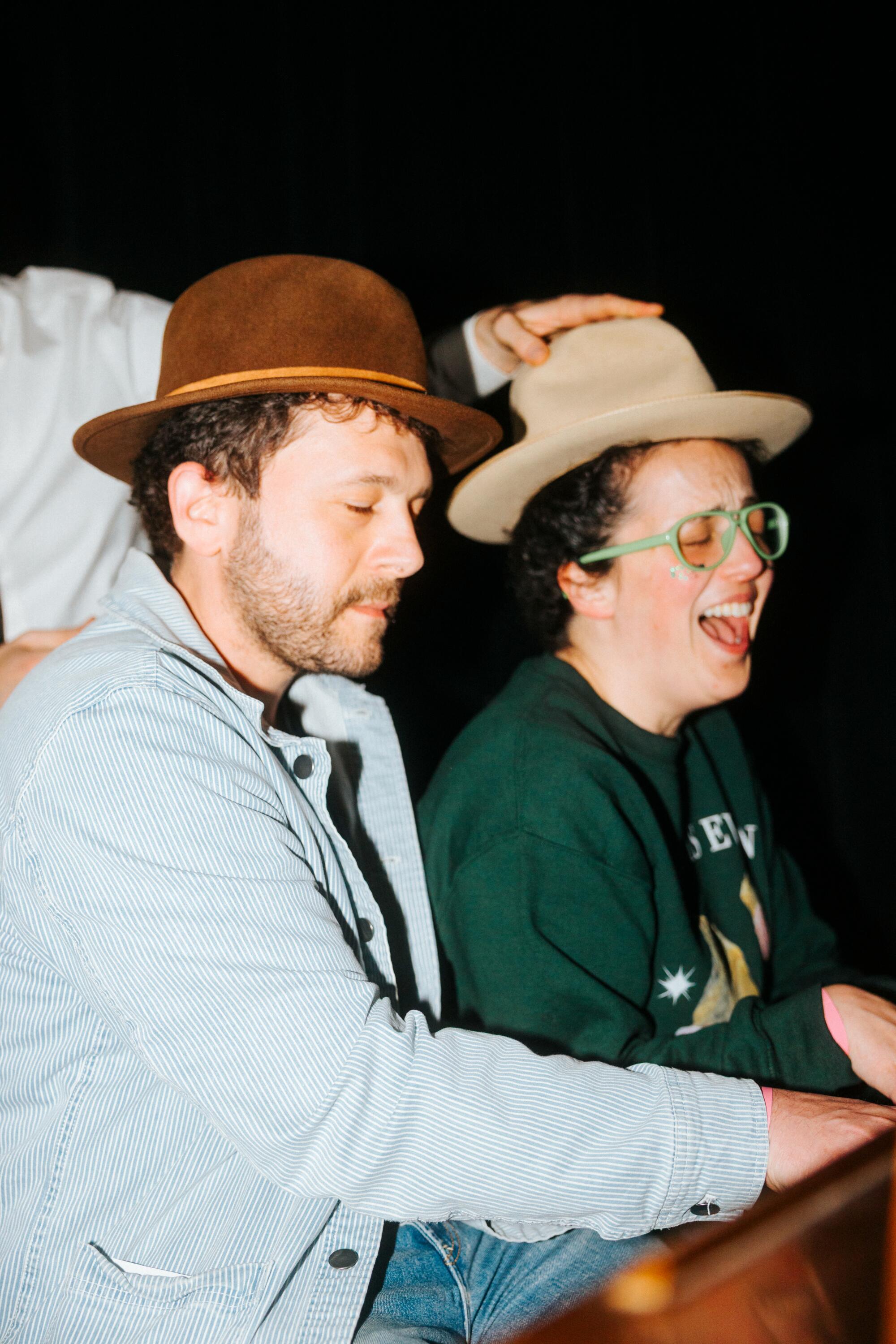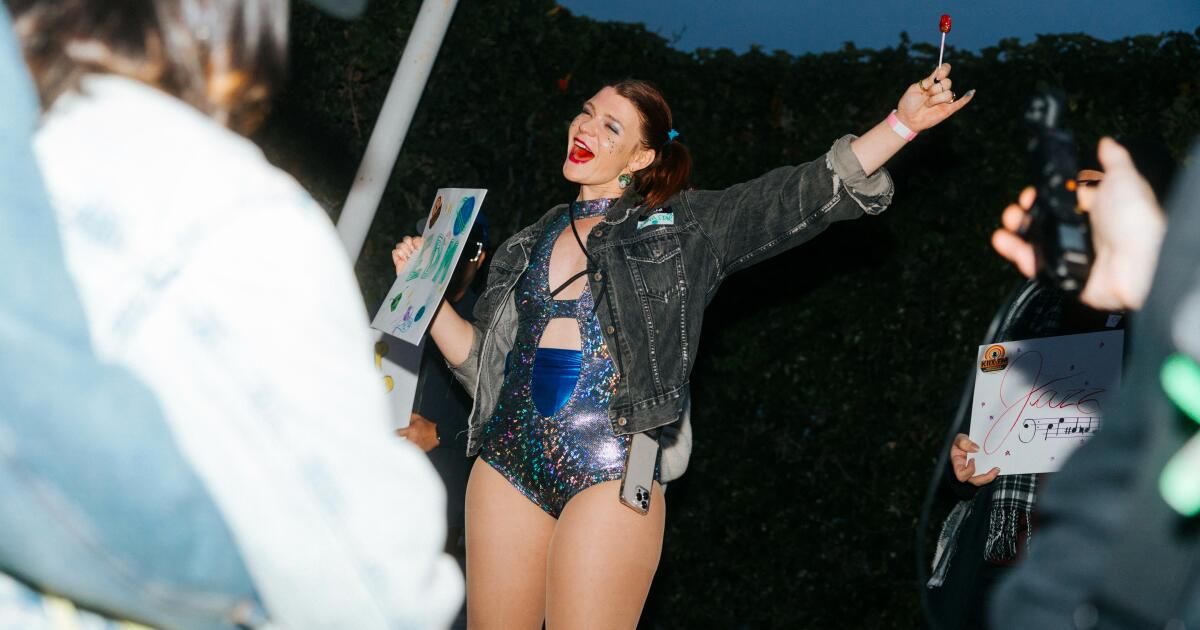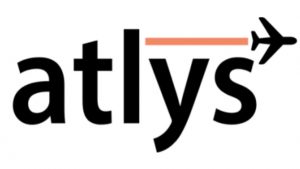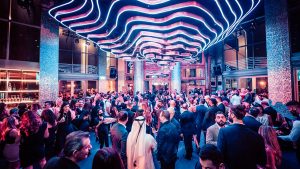Throughout Sunday night, they placed me in a foreign prison, I joined a folk-rock band for a song lifting that involved a murderous bear and ran several times against the teachers of selfish and greedy tasks, once in a comic production in a jazz club and another time in the background of a sown dance space.
A “that's Baby Jazz scene!” of the immersive spies team among us. “Our great goal was to make a simple, understandable and funny piece and expect everything else to fit after that,” says Spies's founder among us, Prescott Gadd.
(Chiara Alexa / for the Times)
And everything felt like freedom, 10 minutes at the same time.
The immersive invitational, now in his fourth year, was presented in collaboration with the LGBT center and the AFter Hours theater company, with the support of the local group The Immersive Experience Institute. The concept: participating companies receive 48 hours to create a new 10 -minute production and then perform it several times on the final day of the event. The public becomes part of the show: “immersive theater” denotes the participation of the ticket buyer, usually interacting or following the cast. There are nonsense, a production involved a cryogenically frozen Swedish rapper, and the general tone is of joviality, the belief that art at the beginning of the 21st century should be increasingly interactive and playable.

In “Bird is The Word” by Dr3am Logikk, the participants were thrown into jail, playing the role of a rock band that made a racket in a foreign land without a name governed by authoritarianism.
(Chiara Alexa / for the Times)
Immersive is a broad term. Everything appears, from lands of large -scale thematic parks, the epic universe of Universal Studios in Florida, which opens on May 22, is perhaps considered the largest immersive occurrence of the year, to the wonders centered on the game as the Sloomoo Slime Museum. The immersive theater tends to lean more niche, but as more generations grow more and more surrounded by games and applications of social networks that depend on gamification techniques, experimenting with ways of merging art and game is considered vital.
“[Participants] Have agency, “says Aaron Vanek, co -founder of Spectacular Disaster Factory, one of the companies in the program.” I think it is an empowering situation when participants are not only immersive in a world, but in reality they affect that world and, in today's current situation, it only has a bit of being able to make a significant change for a person, a characteristic or a story is extremely enriching. “
In this year's invitation, music was given as a broad theme, but the songs often returned to artistic expression: emptiness when they take us, disorder when emotions get involved and power when collaborating with others. Most of the productions nodded to the world outside the corridors of the LGBT Center of Los Angeles in Hollywood, apparently in a broad agreement that life for many in 2025 is full of invisible stressful factors, and yet many also found an edifying spirit by allowing the members of the audience to join in the act of creation.

The now invitational annual presented eight 10 -minute theatrical performances, all focused on a music theme.
(Chiara Alexa / for the Times)
With the limited time period, participating theater teams must quickly establish a place and a sense of purpose, lending to the audience, which must immediately twist to their role as actors, a call to action. We are, for example, free ourselves from a prison in a country without a name or discover who killed classical music. They were different levels of interactivity, as a program gave us, another made us act as puppeteers of a species, and in other places he told us to do a rudimentary dance of bad streets. And the immersive theater, when it works, breaks the barriers, allowing the game act to know our fellow audience members and explore stories and emotions with trained actors.
“There is no season in the immersive theater,” says Graham Wetterhahn, the founding artistic director of After Hours, and points out that many productions have short races. They can often run out. The immersive invitational of Los Angeles is a way, hopefully, to expose the public to several companies to expand their reach.
I had to be literally expelled from “string instruments”, with a spectacular disaster factory, since the program seemed to continue much after its final rhythm. Tonally, it differed much in the immersive invitation, hitting a feeling of horror insane and borders while the public explored the costumes of an electronic music dance club. There, two bottles of bottles sat before makeup mirrors. Our only instruction was to look for ropes with united bright paper points, and these were found after a minute or two in the arms of the actors.

The “string instruments” of the spectacular disaster factory acquired a mysterious tone, in which the public controlled the actors as if they were puppets.
(Chiara Alexa / for the Times)
The scarcely dressed artists spoke in Monotonus: “Lipstick”, “brush”, “pencil”, while the audience took turns around their desks. Occasionally, a superior entered and reminded them and the minutes until it opened. I was affecting. We immediately tried to help the actors to their request, but we could not free them from the grips of the occupation that left them with dead eyes. He inclined to the audience a demanding sense of agency, since we could control the program, but only to some extent.
A diary of one of the actors, open on the desk, said he was afflicting the loss of his future. “Rope instruments” was a job that left the audience without a final time of compliance with wishes. There was no lifting, or quitting smoking, and that emptiness seemed the way to follow. And yet, there was a sense of comfort in his monotony, the simple act of looking for articles on a desk and leading an actor creating a sense of calm that sought to ask questions about the ways in which we unfairly accept.
“We come to the immersive theater from an opposite edge,” says Kirsten Hageeit, co -founder of Spectacular Disaster Factory, Kirsten Hageeit. “Many people come from the traditional theater. There are people from the escape rooms. We venerate the game of live action roles and a type of roles game where it is not written.”

Members of the audience at the Immersive Invitational play a piano in “That is Jazz Baby!” of spies among us.
(Chiara Alexa / for the Times)
“That's Baby Jazz!” Of the spies among us, the team behind a long long -term Tokyo espionage story found a similar lack of life in corporate work, this time in a jazz nightclub. Only here, the goal was more cheerful and the audience managed to free artists from the claws of an exaggeratedly maniac owner. The public had to release a picture of hypnosis musicians and make it inventing scenarios in which the club's owner was continually forced to leave the room. We put on wigs and touched instruments while fighting for equity in a program that argued that the appeal of music was not perfectionism or talent, but of the community.

Classical music, genre, was killed in “accommodating the score” meanwhile … Netprov Studio.
(Chiara Alexa / for the Times)
Spy Brunch found inspiration in the era of protest music of the 60s in his “Ursa Major and the hexes of Mountain Blue”, turning the members of the audience into improvised musicians in their mischievous show about the defeat of a government agent. The story took a metaphorically magical inclination, focusing on the power of music to join, and potentially summon a bear. “Bird is The Word” by Dr3am Logikk had similar messages, but he did it through an environment in which rock 'N' Roll was banned and his musicians inspired by the clash were imprisoned for making a racket in a foreign land. To combat authoritarianism, we had to create an inspiring song that would not use instruments or animal noises. Both were programs that inspired connections and vulnerability, part of the euphoria of communal art.
Emotional volatility was played in “Frog and Toad: Live in concert!” From Last Call Theater, one of the most prolific companies in the immersive scene. He played with the group's adventure strengths, matching the members of the audience with an actor in an attempt to prevent a band from breaking. The old tension between artistic and trade originality was explored, and our team failed to find a commitment. The queen's fools were a slightly more traditional theater route with “Devil On My Hoarse”, in which we were fed with the actors in a show that argued that even more passive productions can find ways to make the public lean.
Occasionally there is an absurd in interactive fiction. “Ismusik” by Cherry Poppins and, meanwhile … “Settling the Score” by Netprov Studio put the emphasis on comic improvisation, the first one presented himself to the mini challenges of the US of classical music. However, underlying each one there were subtle statements about the search for fame in our commercial age.
Large messages can decrease, or even slightly disguised, in immersive entertainment. That is because we are playing, and when we play we are at the time. We are also a little out of the head space and ready to buy in worlds of astonishment or even conflicts. And in the immersive invitation, where productions went from dumb to heavy, there was a common common denominator, and that is that the immersive game can inspire a radical joy.












